A 22 years experienced manufacturer who has cooperated with 380 brands
- All
- Product Name
- Product Keyword
- Product Model
- Product Summary
- Product Description
- Multi Field Search
Author: Site Editor Publish Time: 2025-07-03 Origin: Site
With the continuous improvement of global environmental awareness and the increasingly serious energy crisis, the traditional energy-consuming lighting methods have gradually failed to meet the demands of modern society. Solar lamps, as a new type of environmentally friendly lighting tool, have gradually become an indispensable part of outdoor lighting and home decoration due to their features such as zero electricity charges, green energy, and easy installation. It not only meets people's demands for lighting functions, but also makes positive contributions in energy conservation, emission reduction and environmental protection.
1. The basic working principle of solar lamps
The working principle of solar lamps is simple and efficient. It is mainly composed of solar panels, batteries, LED light sources and control systems. During the day, solar panels absorb sunlight, convert it into electrical energy, and store the electrical energy in batteries. At night, the battery provides power to drive the LED lamps to light up.
This lighting method that relies on natural energy (solar energy) not only saves electricity expenses but also significantly reduces the reliance on traditional power grids, avoiding environmental pollution caused by the use of electricity. The high efficiency and environmental friendliness of solar lamps make them the representative of modern green lighting.
2.Advantages of solar lamps
The greatest advantage of energy-saving and environmentally friendly solar lamps lies in their energy conservation and environmental protection. It greatly reduces traditional electricity consumption by making use of solar energy, a green and renewable energy source. With the popularization of solar energy and the continuous development of technology, solar lamps not only save users' electricity bills but also reduce carbon emissions, having a positive impact on the environment.
Compared with traditional electric lighting methods, solar lamps do not require external power support. They are automatically charged by solar energy during the day and do not need to pay for electricity at night. Especially in some remote areas or places with unstable power supply, the application of solar lamps can effectively reduce power demand and solve the lighting problem.
Solar lamps are easy to install and maintain. They are simple to install and usually do not require the laying of cables or complex circuits. Users only need to place the solar lamps in a sunny spot to ensure that the solar panels can absorb sunlight to the maximum extent. Most solar lamps are designed wirelessly, making them highly suitable for outdoor use and not restricted by power supply. Due to its simple structure, daily maintenance is also relatively easy. The main task is to clean the solar panels regularly to maintain their efficient charging capacity.
Adaptable solar lamps are not only suitable for courtyard, garden, road lighting and other places in cities, but also very suitable for remote areas, rural areas and other regions lacking stable power supply. Solar lamps can also provide convenient lighting solutions in outdoor activities such as camping, hiking and beachcombing in the wild. In addition, many solar lamps also feature water resistance, wind resistance, and UV resistance, making them adaptable to various harsh weather conditions and capable of being used outdoors for long periods of time.
With the development of technology, many solar lamps are also equipped with intelligent sensing systems that can automatically turn the lamps on and off according to changes in ambient light. During the day, the lamps will automatically turn off to charge. At night or when there is insufficient light, the lamps will automatically turn on to provide illumination. In addition, some solar lamps are equipped with motion sensors that can automatically light up when they sense human activity, further enhancing energy-saving effects and practicality.

3. Application fields of solar lamps
One of the most widely used fields for outdoor lighting solar lamps is outdoor lighting. Whether it's a family garden, courtyard, walkway, park, square or street, solar lamps can provide stable lighting effects. Solar garden lamps and solar street lamps have become the first choice for many residential areas and public places. Especially in some remote areas, solar lamps have solved the problem of insufficient power supply and provided safe outdoor lighting.
Solar lamps for safety lighting can also be used as safety lighting. Many solar lamps are equipped with motion sensors that automatically light up when they sense human movement. They can not only provide illumination but also serve as anti-theft lighting systems, enhancing safety. Solar security lights installed in front of the door, on the courtyard wall or near the window can effectively deter the intrusion of lawbreakers and protect the safety of the home.
In addition to its practicality, solar lamps are also widely used in decorative lighting. The design of solar lamps can not only meet the lighting needs but also add decorative effects to courtyards, gardens, courtyard walls, etc. For instance, solar-powered landscape lights, garden lights, lawn lights, etc., can create a romantic and warm atmosphere for the courtyard at night and enhance the quality of family life.
In the event of a power outage or disaster, solar lamps can serve as emergency lighting tools. Especially some solar lamps with built-in battery energy storage can provide a stable light source in the event of a power shortage, ensuring that users' daily lives are not affected. In addition, solar-powered flashlights are also one of the emergency backup tools, suitable for use in outdoor activities such as families, camping, and mountain climbing.
4.The Future development of solar lamps
With the advancement of technology and the gradual reduction of production costs, the popularity of solar lamps will continue to increase. In the future, solar lamps will be more intelligent and automated, featuring more functions such as integrated wireless charging, smart home control, and light-sensing adjustment, further enhancing the user experience. In addition, the design of solar lamps will become more diverse. Besides traditional street lamps and garden lamps, there will be more designs that match home and commercial environments in the future. More efficient solar panels and the improvement of energy storage technology will also significantly enhance the charging efficiency and endurance of solar lamps, enabling them to be applied in a wider range of fields.

5. Conclusion: Moving towards a green and low-carbon future
Solar lamps, as an environmentally friendly and energy-saving lighting option, are being widely adopted in an increasing number of households, enterprises and public places. It not only effectively saves energy and reduces carbon emissions, but also, with its low cost and high efficiency, solves many problems such as insufficient power supply and inadequate outdoor lighting in remote areas. Meanwhile, the multi-functionality, ease of installation and low maintenance cost of solar lamps make them an ideal choice for many places. With the continuous development of solar energy technology, solar lamps will play a significant role in more scenarios, helping us move towards a greener, low-carbon and sustainable future.
content is empty!